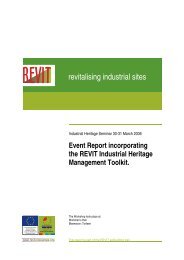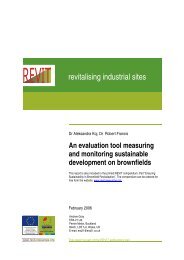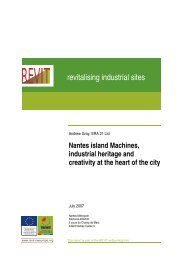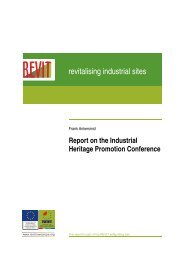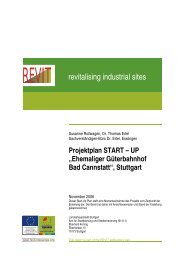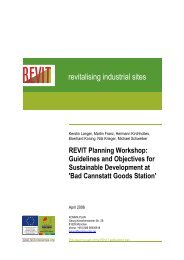REVIT Heritage Report.pdf
REVIT Heritage Report.pdf
REVIT Heritage Report.pdf
You also want an ePaper? Increase the reach of your titles
YUMPU automatically turns print PDFs into web optimized ePapers that Google loves.
Torfaen County Borough Council<br />
<strong>REVIT</strong>: A Review of the Conservation of Industrial <strong>Heritage</strong> Assets on Brownfield Sites<br />
3 Industrial <strong>Heritage</strong>: Legal and Policy Background<br />
3.1 International Overview<br />
3.1.1 In 1972 the United Nations Educational, Scientific and Cultural Organization<br />
(UNESCO) produced the Convention Concerning the Protection of the World<br />
Cultural and Natural <strong>Heritage</strong> which sought to protect the cultural heritage in<br />
signatory areas.<br />
3.1.2 UNESCO produces the list of World <strong>Heritage</strong> Sites (WHS), under the advice of<br />
the International Council on Monuments and Sites (ICOMOS), which seeks to<br />
protect sites of international importance.<br />
3.1.3 The standards of the Council of Europe are indicated in a series of Convention<br />
for the safeguarding:<br />
• architectural heritage (Grenada, October 3, 1985),<br />
• convention on the protection of the archaeological inheritance (Valetta,<br />
January 16, 1992)<br />
• landscape (Florence, October 20, 2000). European Convention Generally<br />
the recommendations of the Council of Europe in the field of the heritage<br />
are taken into account in the national legislation.<br />
3.2 England<br />
<strong>Heritage</strong> Bodies<br />
3.2.1 In England the Department of Culture, Media and Sport (DCMS) is the central<br />
UK Government Department responsible for Government policy on the arts,<br />
sport and recreation, the National Lottery, libraries, museums and galleries,<br />
export licensing of cultural goods, broadcasting, film, press freedom and<br />
regulation, the built heritage, the royal estate and tourism.<br />
3.2.2 In England various government supported bodies protect and manage the<br />
archaeological and built heritage. These organizations recommend to the<br />
relevant minister buildings for listing and monuments for scheduling and parks<br />
and gardens for registering as well as retaining the definitive base data on<br />
such protected sites.<br />
3.2.3 In England the executive organization responsible for the protection of<br />
archaeological sites, monuments, listed buildings and parks and gardens is<br />
English <strong>Heritage</strong> (EH). Some movement towards centralisation of heritage<br />
functions has taken place in England, as the Royal Commission on Historical<br />
Monuments of England, which maintains its own National Monument Records,<br />
has been absorbed into EH.<br />
3.2.4 At a local level, in England local planning authorities usually retain their own<br />
archaeological staff who advise on the archaeological impact of planning<br />
applications. In England these archaeological groups maintain databases of<br />
their areas called the Sites and Monuments Record (SMR), increasingly known<br />
as Historic Environment Records (HER).<br />
3.2.5 In England the various local authorities also generally retain their own<br />
architectural conservation staff, although some rely on consultants or adjacent<br />
local authority staff to fill this function. The conservation staff provides advice<br />
0014021/JM/001 5




